Schizophrenia: Symptoms, Causes, and Treatment
VerifiedAdded on 2023/04/22
|9
|2047
|118
AI Summary
Schizophrenia is a disorder that affects the brain characterized by alterations in thinking, social contacts, emotional responsiveness and how one perceives things. It affects one’s thinking, feeling and behavior and affected people may seem to have lost association with reality. Learn more about the symptoms, causes, and treatment of schizophrenia on Desklib.
Contribute Materials
Your contribution can guide someone’s learning journey. Share your
documents today.

Running head: SCHIZOPHRENIA
1
Schizophrenia
Student’s Name
Professor’s Name
1
Schizophrenia
Student’s Name
Professor’s Name
Secure Best Marks with AI Grader
Need help grading? Try our AI Grader for instant feedback on your assignments.
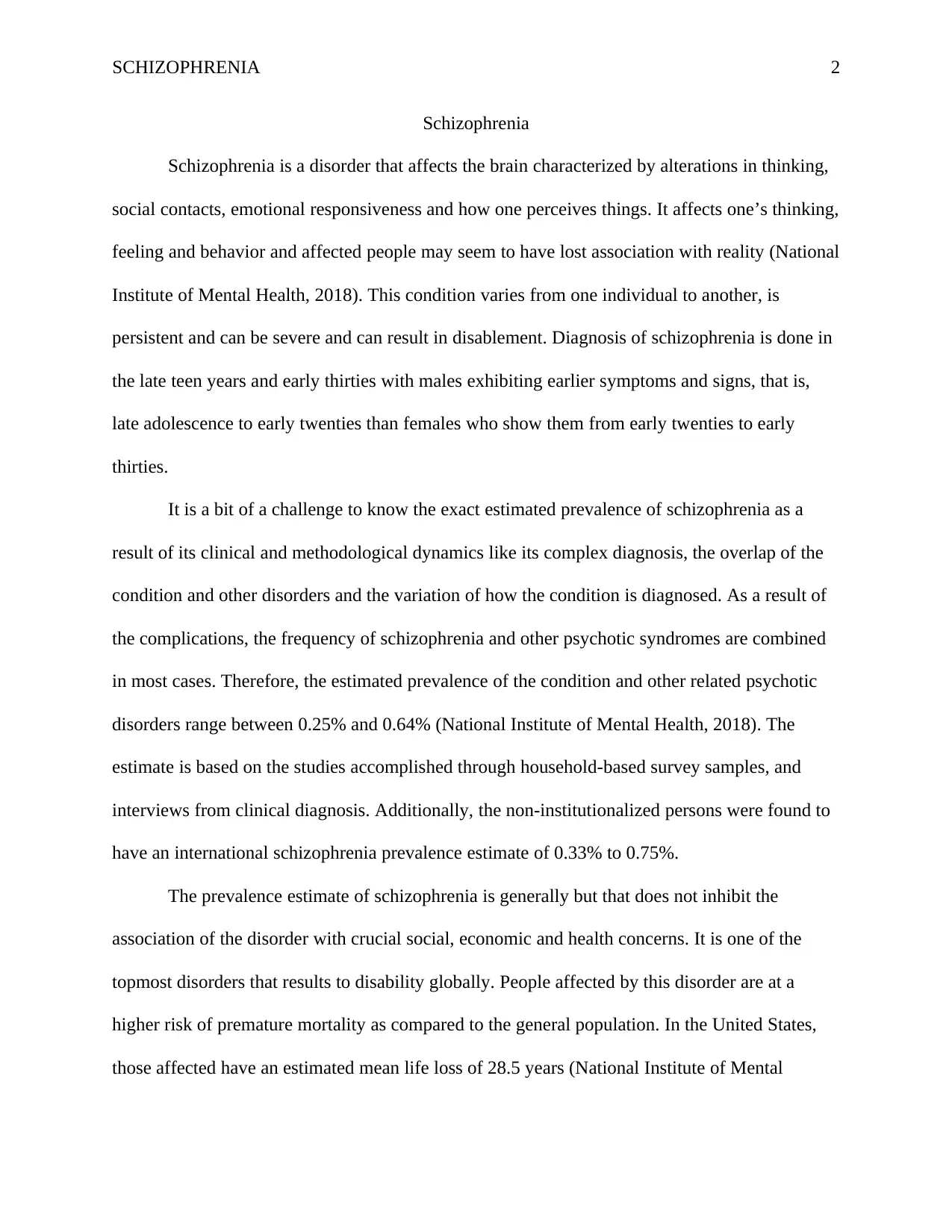
SCHIZOPHRENIA 2
Schizophrenia
Schizophrenia is a disorder that affects the brain characterized by alterations in thinking,
social contacts, emotional responsiveness and how one perceives things. It affects one’s thinking,
feeling and behavior and affected people may seem to have lost association with reality (National
Institute of Mental Health, 2018). This condition varies from one individual to another, is
persistent and can be severe and can result in disablement. Diagnosis of schizophrenia is done in
the late teen years and early thirties with males exhibiting earlier symptoms and signs, that is,
late adolescence to early twenties than females who show them from early twenties to early
thirties.
It is a bit of a challenge to know the exact estimated prevalence of schizophrenia as a
result of its clinical and methodological dynamics like its complex diagnosis, the overlap of the
condition and other disorders and the variation of how the condition is diagnosed. As a result of
the complications, the frequency of schizophrenia and other psychotic syndromes are combined
in most cases. Therefore, the estimated prevalence of the condition and other related psychotic
disorders range between 0.25% and 0.64% (National Institute of Mental Health, 2018). The
estimate is based on the studies accomplished through household-based survey samples, and
interviews from clinical diagnosis. Additionally, the non-institutionalized persons were found to
have an international schizophrenia prevalence estimate of 0.33% to 0.75%.
The prevalence estimate of schizophrenia is generally but that does not inhibit the
association of the disorder with crucial social, economic and health concerns. It is one of the
topmost disorders that results to disability globally. People affected by this disorder are at a
higher risk of premature mortality as compared to the general population. In the United States,
those affected have an estimated mean life loss of 28.5 years (National Institute of Mental
Schizophrenia
Schizophrenia is a disorder that affects the brain characterized by alterations in thinking,
social contacts, emotional responsiveness and how one perceives things. It affects one’s thinking,
feeling and behavior and affected people may seem to have lost association with reality (National
Institute of Mental Health, 2018). This condition varies from one individual to another, is
persistent and can be severe and can result in disablement. Diagnosis of schizophrenia is done in
the late teen years and early thirties with males exhibiting earlier symptoms and signs, that is,
late adolescence to early twenties than females who show them from early twenties to early
thirties.
It is a bit of a challenge to know the exact estimated prevalence of schizophrenia as a
result of its clinical and methodological dynamics like its complex diagnosis, the overlap of the
condition and other disorders and the variation of how the condition is diagnosed. As a result of
the complications, the frequency of schizophrenia and other psychotic syndromes are combined
in most cases. Therefore, the estimated prevalence of the condition and other related psychotic
disorders range between 0.25% and 0.64% (National Institute of Mental Health, 2018). The
estimate is based on the studies accomplished through household-based survey samples, and
interviews from clinical diagnosis. Additionally, the non-institutionalized persons were found to
have an international schizophrenia prevalence estimate of 0.33% to 0.75%.
The prevalence estimate of schizophrenia is generally but that does not inhibit the
association of the disorder with crucial social, economic and health concerns. It is one of the
topmost disorders that results to disability globally. People affected by this disorder are at a
higher risk of premature mortality as compared to the general population. In the United States,
those affected have an estimated mean life loss of 28.5 years (National Institute of Mental
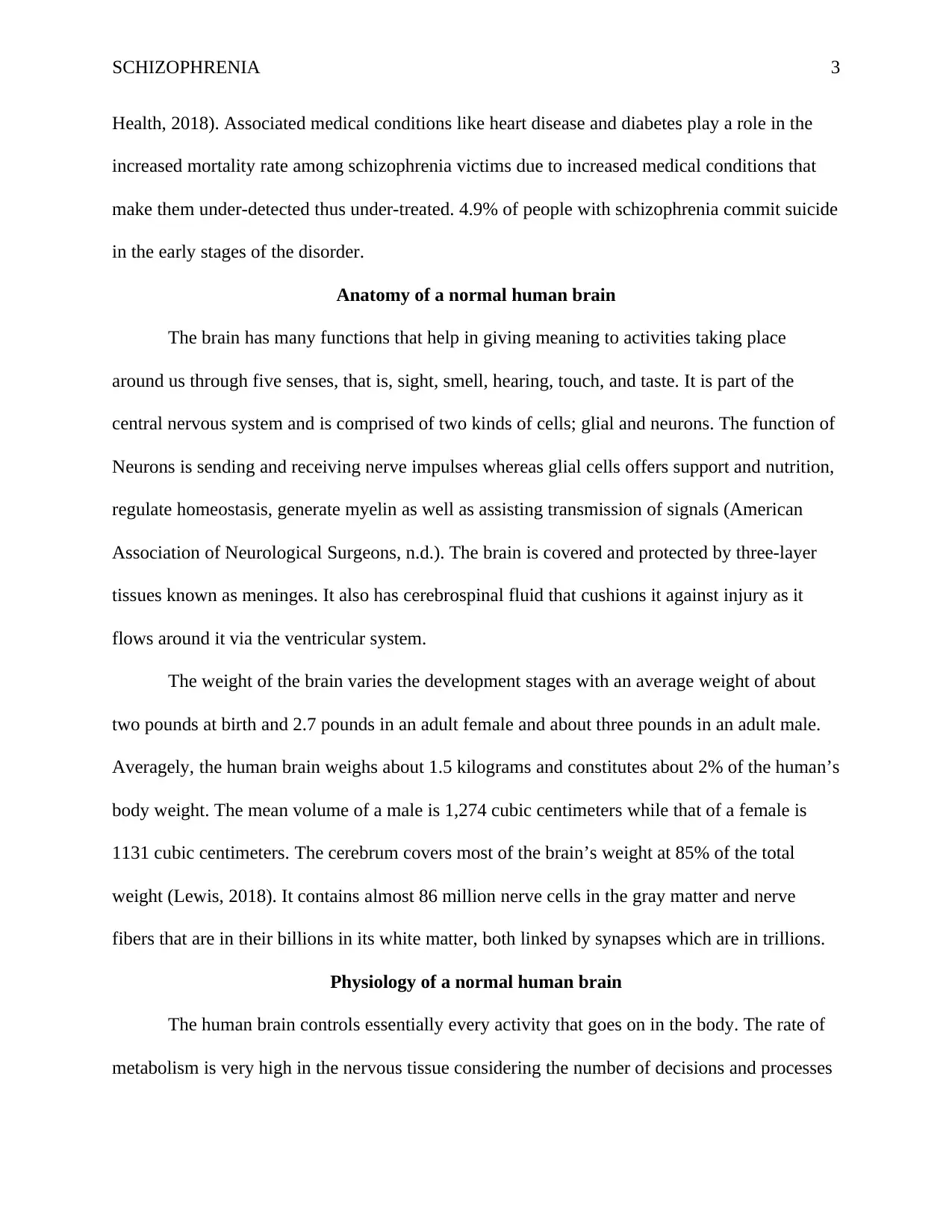
SCHIZOPHRENIA 3
Health, 2018). Associated medical conditions like heart disease and diabetes play a role in the
increased mortality rate among schizophrenia victims due to increased medical conditions that
make them under-detected thus under-treated. 4.9% of people with schizophrenia commit suicide
in the early stages of the disorder.
Anatomy of a normal human brain
The brain has many functions that help in giving meaning to activities taking place
around us through five senses, that is, sight, smell, hearing, touch, and taste. It is part of the
central nervous system and is comprised of two kinds of cells; glial and neurons. The function of
Neurons is sending and receiving nerve impulses whereas glial cells offers support and nutrition,
regulate homeostasis, generate myelin as well as assisting transmission of signals (American
Association of Neurological Surgeons, n.d.). The brain is covered and protected by three-layer
tissues known as meninges. It also has cerebrospinal fluid that cushions it against injury as it
flows around it via the ventricular system.
The weight of the brain varies the development stages with an average weight of about
two pounds at birth and 2.7 pounds in an adult female and about three pounds in an adult male.
Averagely, the human brain weighs about 1.5 kilograms and constitutes about 2% of the human’s
body weight. The mean volume of a male is 1,274 cubic centimeters while that of a female is
1131 cubic centimeters. The cerebrum covers most of the brain’s weight at 85% of the total
weight (Lewis, 2018). It contains almost 86 million nerve cells in the gray matter and nerve
fibers that are in their billions in its white matter, both linked by synapses which are in trillions.
Physiology of a normal human brain
The human brain controls essentially every activity that goes on in the body. The rate of
metabolism is very high in the nervous tissue considering the number of decisions and processes
Health, 2018). Associated medical conditions like heart disease and diabetes play a role in the
increased mortality rate among schizophrenia victims due to increased medical conditions that
make them under-detected thus under-treated. 4.9% of people with schizophrenia commit suicide
in the early stages of the disorder.
Anatomy of a normal human brain
The brain has many functions that help in giving meaning to activities taking place
around us through five senses, that is, sight, smell, hearing, touch, and taste. It is part of the
central nervous system and is comprised of two kinds of cells; glial and neurons. The function of
Neurons is sending and receiving nerve impulses whereas glial cells offers support and nutrition,
regulate homeostasis, generate myelin as well as assisting transmission of signals (American
Association of Neurological Surgeons, n.d.). The brain is covered and protected by three-layer
tissues known as meninges. It also has cerebrospinal fluid that cushions it against injury as it
flows around it via the ventricular system.
The weight of the brain varies the development stages with an average weight of about
two pounds at birth and 2.7 pounds in an adult female and about three pounds in an adult male.
Averagely, the human brain weighs about 1.5 kilograms and constitutes about 2% of the human’s
body weight. The mean volume of a male is 1,274 cubic centimeters while that of a female is
1131 cubic centimeters. The cerebrum covers most of the brain’s weight at 85% of the total
weight (Lewis, 2018). It contains almost 86 million nerve cells in the gray matter and nerve
fibers that are in their billions in its white matter, both linked by synapses which are in trillions.
Physiology of a normal human brain
The human brain controls essentially every activity that goes on in the body. The rate of
metabolism is very high in the nervous tissue considering the number of decisions and processes
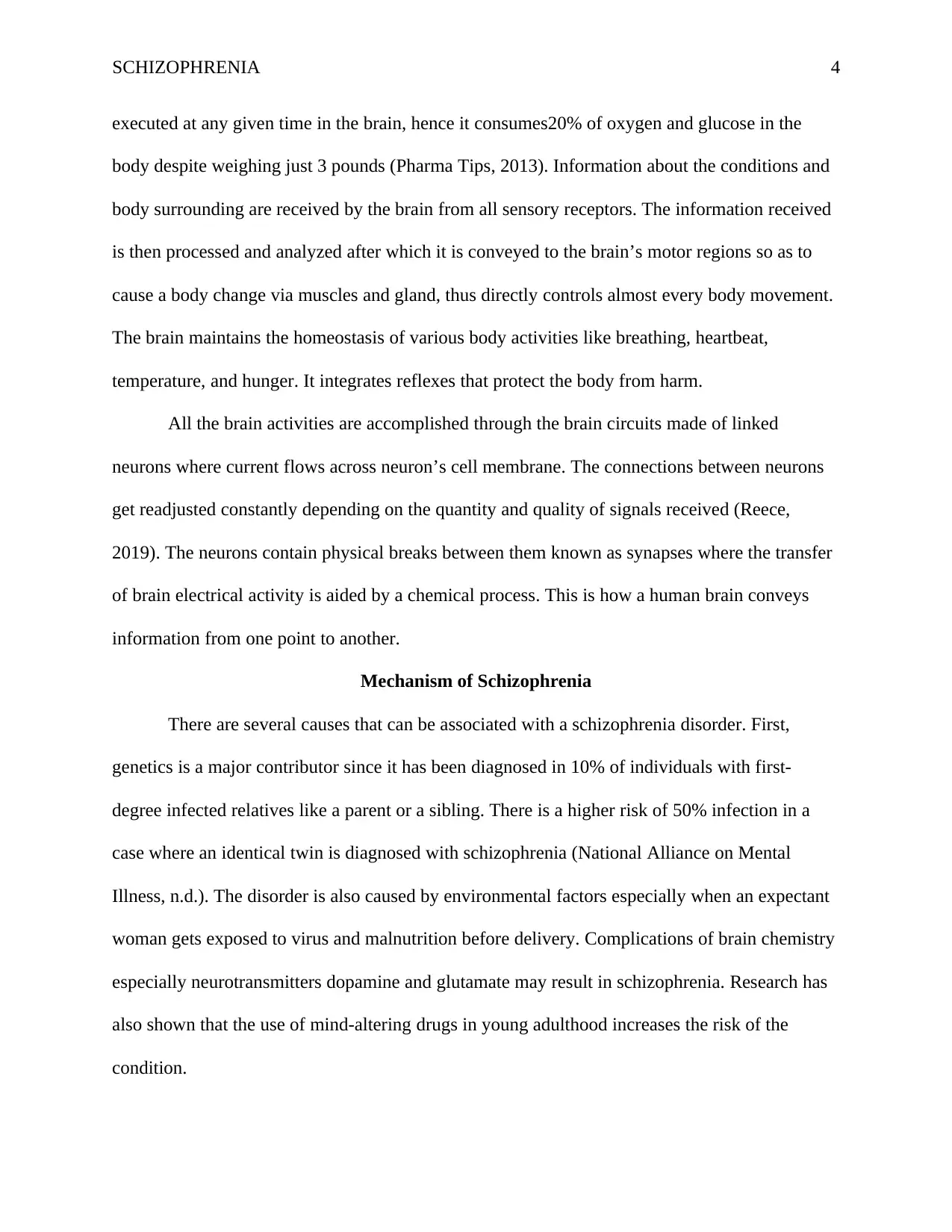
SCHIZOPHRENIA 4
executed at any given time in the brain, hence it consumes20% of oxygen and glucose in the
body despite weighing just 3 pounds (Pharma Tips, 2013). Information about the conditions and
body surrounding are received by the brain from all sensory receptors. The information received
is then processed and analyzed after which it is conveyed to the brain’s motor regions so as to
cause a body change via muscles and gland, thus directly controls almost every body movement.
The brain maintains the homeostasis of various body activities like breathing, heartbeat,
temperature, and hunger. It integrates reflexes that protect the body from harm.
All the brain activities are accomplished through the brain circuits made of linked
neurons where current flows across neuron’s cell membrane. The connections between neurons
get readjusted constantly depending on the quantity and quality of signals received (Reece,
2019). The neurons contain physical breaks between them known as synapses where the transfer
of brain electrical activity is aided by a chemical process. This is how a human brain conveys
information from one point to another.
Mechanism of Schizophrenia
There are several causes that can be associated with a schizophrenia disorder. First,
genetics is a major contributor since it has been diagnosed in 10% of individuals with first-
degree infected relatives like a parent or a sibling. There is a higher risk of 50% infection in a
case where an identical twin is diagnosed with schizophrenia (National Alliance on Mental
Illness, n.d.). The disorder is also caused by environmental factors especially when an expectant
woman gets exposed to virus and malnutrition before delivery. Complications of brain chemistry
especially neurotransmitters dopamine and glutamate may result in schizophrenia. Research has
also shown that the use of mind-altering drugs in young adulthood increases the risk of the
condition.
executed at any given time in the brain, hence it consumes20% of oxygen and glucose in the
body despite weighing just 3 pounds (Pharma Tips, 2013). Information about the conditions and
body surrounding are received by the brain from all sensory receptors. The information received
is then processed and analyzed after which it is conveyed to the brain’s motor regions so as to
cause a body change via muscles and gland, thus directly controls almost every body movement.
The brain maintains the homeostasis of various body activities like breathing, heartbeat,
temperature, and hunger. It integrates reflexes that protect the body from harm.
All the brain activities are accomplished through the brain circuits made of linked
neurons where current flows across neuron’s cell membrane. The connections between neurons
get readjusted constantly depending on the quantity and quality of signals received (Reece,
2019). The neurons contain physical breaks between them known as synapses where the transfer
of brain electrical activity is aided by a chemical process. This is how a human brain conveys
information from one point to another.
Mechanism of Schizophrenia
There are several causes that can be associated with a schizophrenia disorder. First,
genetics is a major contributor since it has been diagnosed in 10% of individuals with first-
degree infected relatives like a parent or a sibling. There is a higher risk of 50% infection in a
case where an identical twin is diagnosed with schizophrenia (National Alliance on Mental
Illness, n.d.). The disorder is also caused by environmental factors especially when an expectant
woman gets exposed to virus and malnutrition before delivery. Complications of brain chemistry
especially neurotransmitters dopamine and glutamate may result in schizophrenia. Research has
also shown that the use of mind-altering drugs in young adulthood increases the risk of the
condition.
Secure Best Marks with AI Grader
Need help grading? Try our AI Grader for instant feedback on your assignments.
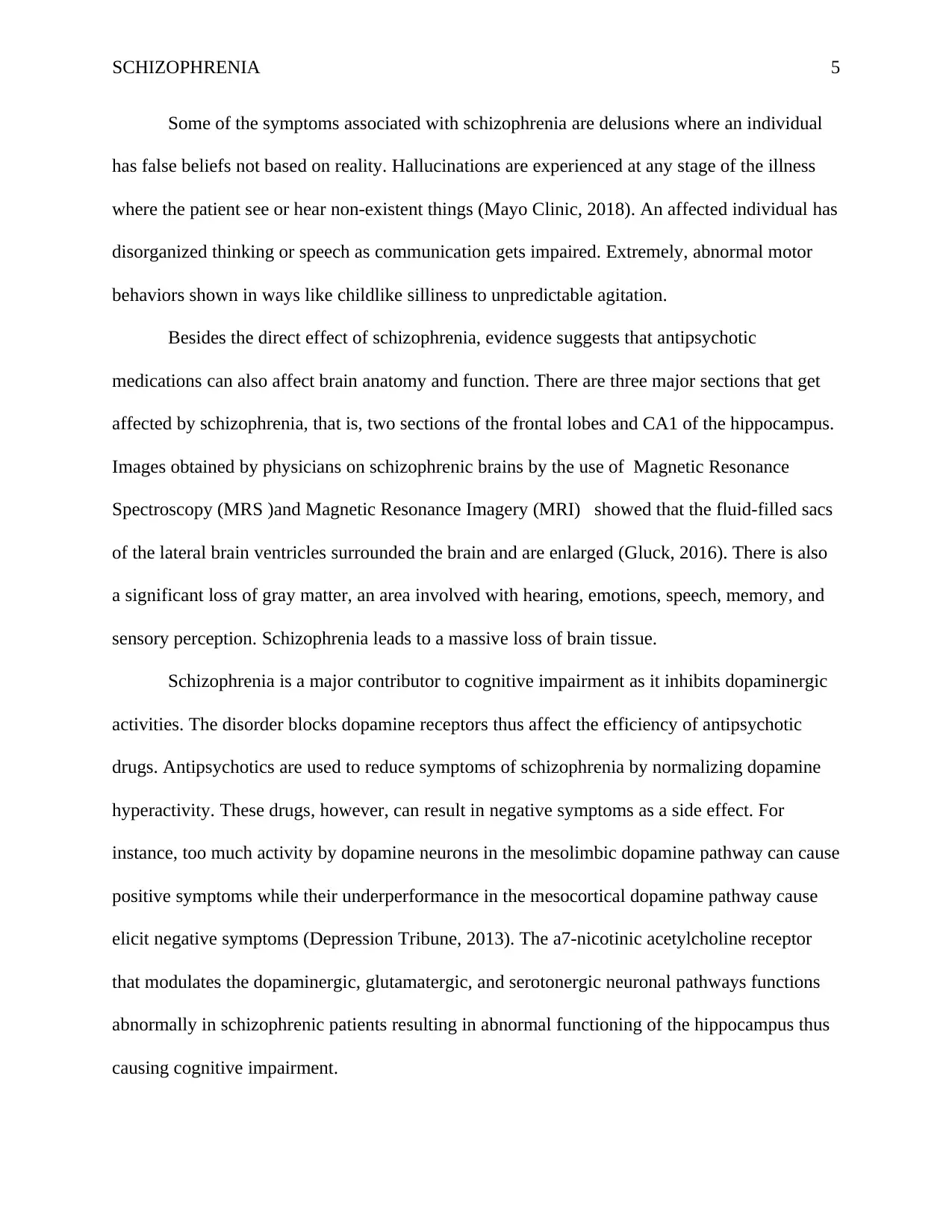
SCHIZOPHRENIA 5
Some of the symptoms associated with schizophrenia are delusions where an individual
has false beliefs not based on reality. Hallucinations are experienced at any stage of the illness
where the patient see or hear non-existent things (Mayo Clinic, 2018). An affected individual has
disorganized thinking or speech as communication gets impaired. Extremely, abnormal motor
behaviors shown in ways like childlike silliness to unpredictable agitation.
Besides the direct effect of schizophrenia, evidence suggests that antipsychotic
medications can also affect brain anatomy and function. There are three major sections that get
affected by schizophrenia, that is, two sections of the frontal lobes and CA1 of the hippocampus.
Images obtained by physicians on schizophrenic brains by the use of Magnetic Resonance
Spectroscopy (MRS )and Magnetic Resonance Imagery (MRI) showed that the fluid-filled sacs
of the lateral brain ventricles surrounded the brain and are enlarged (Gluck, 2016). There is also
a significant loss of gray matter, an area involved with hearing, emotions, speech, memory, and
sensory perception. Schizophrenia leads to a massive loss of brain tissue.
Schizophrenia is a major contributor to cognitive impairment as it inhibits dopaminergic
activities. The disorder blocks dopamine receptors thus affect the efficiency of antipsychotic
drugs. Antipsychotics are used to reduce symptoms of schizophrenia by normalizing dopamine
hyperactivity. These drugs, however, can result in negative symptoms as a side effect. For
instance, too much activity by dopamine neurons in the mesolimbic dopamine pathway can cause
positive symptoms while their underperformance in the mesocortical dopamine pathway cause
elicit negative symptoms (Depression Tribune, 2013). The a7-nicotinic acetylcholine receptor
that modulates the dopaminergic, glutamatergic, and serotonergic neuronal pathways functions
abnormally in schizophrenic patients resulting in abnormal functioning of the hippocampus thus
causing cognitive impairment.
Some of the symptoms associated with schizophrenia are delusions where an individual
has false beliefs not based on reality. Hallucinations are experienced at any stage of the illness
where the patient see or hear non-existent things (Mayo Clinic, 2018). An affected individual has
disorganized thinking or speech as communication gets impaired. Extremely, abnormal motor
behaviors shown in ways like childlike silliness to unpredictable agitation.
Besides the direct effect of schizophrenia, evidence suggests that antipsychotic
medications can also affect brain anatomy and function. There are three major sections that get
affected by schizophrenia, that is, two sections of the frontal lobes and CA1 of the hippocampus.
Images obtained by physicians on schizophrenic brains by the use of Magnetic Resonance
Spectroscopy (MRS )and Magnetic Resonance Imagery (MRI) showed that the fluid-filled sacs
of the lateral brain ventricles surrounded the brain and are enlarged (Gluck, 2016). There is also
a significant loss of gray matter, an area involved with hearing, emotions, speech, memory, and
sensory perception. Schizophrenia leads to a massive loss of brain tissue.
Schizophrenia is a major contributor to cognitive impairment as it inhibits dopaminergic
activities. The disorder blocks dopamine receptors thus affect the efficiency of antipsychotic
drugs. Antipsychotics are used to reduce symptoms of schizophrenia by normalizing dopamine
hyperactivity. These drugs, however, can result in negative symptoms as a side effect. For
instance, too much activity by dopamine neurons in the mesolimbic dopamine pathway can cause
positive symptoms while their underperformance in the mesocortical dopamine pathway cause
elicit negative symptoms (Depression Tribune, 2013). The a7-nicotinic acetylcholine receptor
that modulates the dopaminergic, glutamatergic, and serotonergic neuronal pathways functions
abnormally in schizophrenic patients resulting in abnormal functioning of the hippocampus thus
causing cognitive impairment.
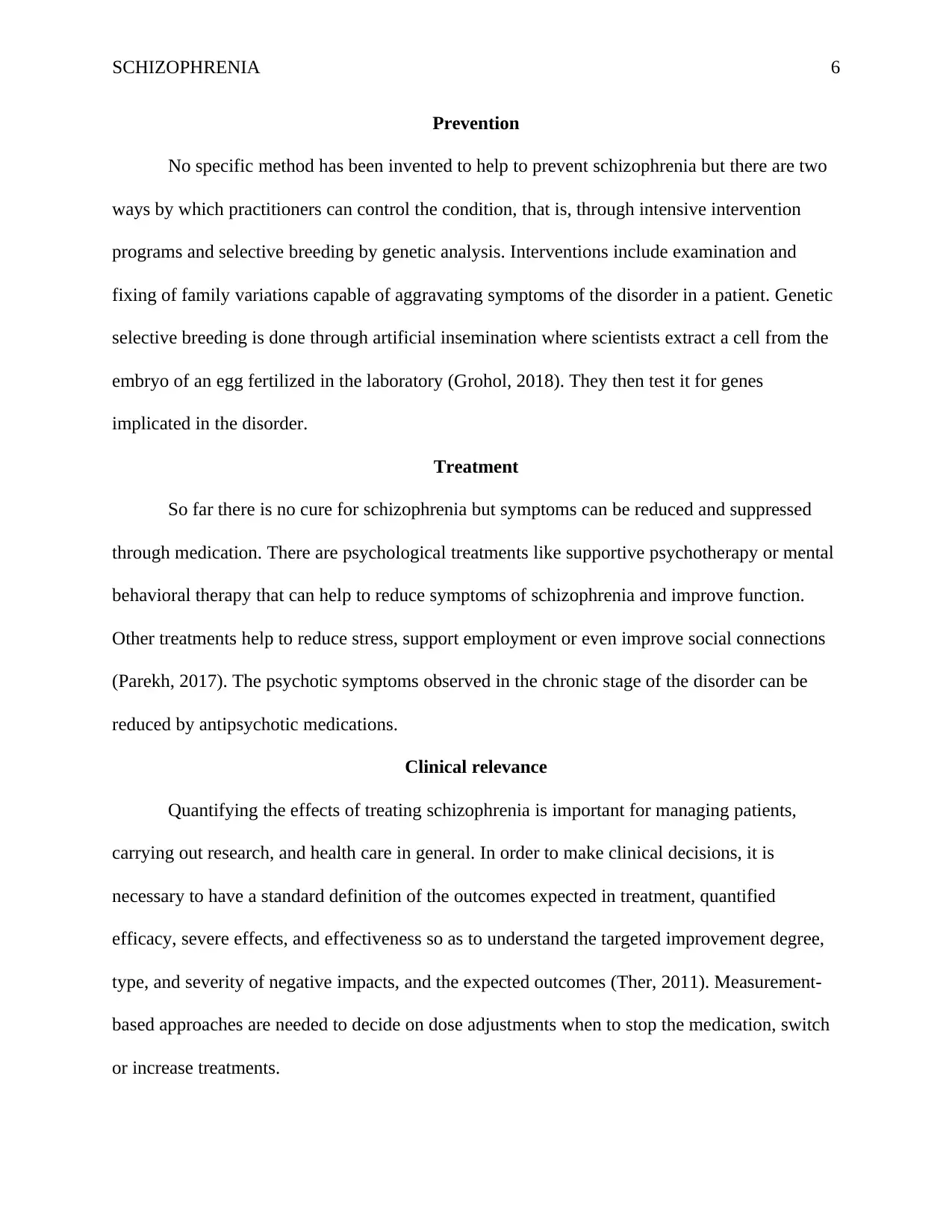
SCHIZOPHRENIA 6
Prevention
No specific method has been invented to help to prevent schizophrenia but there are two
ways by which practitioners can control the condition, that is, through intensive intervention
programs and selective breeding by genetic analysis. Interventions include examination and
fixing of family variations capable of aggravating symptoms of the disorder in a patient. Genetic
selective breeding is done through artificial insemination where scientists extract a cell from the
embryo of an egg fertilized in the laboratory (Grohol, 2018). They then test it for genes
implicated in the disorder.
Treatment
So far there is no cure for schizophrenia but symptoms can be reduced and suppressed
through medication. There are psychological treatments like supportive psychotherapy or mental
behavioral therapy that can help to reduce symptoms of schizophrenia and improve function.
Other treatments help to reduce stress, support employment or even improve social connections
(Parekh, 2017). The psychotic symptoms observed in the chronic stage of the disorder can be
reduced by antipsychotic medications.
Clinical relevance
Quantifying the effects of treating schizophrenia is important for managing patients,
carrying out research, and health care in general. In order to make clinical decisions, it is
necessary to have a standard definition of the outcomes expected in treatment, quantified
efficacy, severe effects, and effectiveness so as to understand the targeted improvement degree,
type, and severity of negative impacts, and the expected outcomes (Ther, 2011). Measurement-
based approaches are needed to decide on dose adjustments when to stop the medication, switch
or increase treatments.
Prevention
No specific method has been invented to help to prevent schizophrenia but there are two
ways by which practitioners can control the condition, that is, through intensive intervention
programs and selective breeding by genetic analysis. Interventions include examination and
fixing of family variations capable of aggravating symptoms of the disorder in a patient. Genetic
selective breeding is done through artificial insemination where scientists extract a cell from the
embryo of an egg fertilized in the laboratory (Grohol, 2018). They then test it for genes
implicated in the disorder.
Treatment
So far there is no cure for schizophrenia but symptoms can be reduced and suppressed
through medication. There are psychological treatments like supportive psychotherapy or mental
behavioral therapy that can help to reduce symptoms of schizophrenia and improve function.
Other treatments help to reduce stress, support employment or even improve social connections
(Parekh, 2017). The psychotic symptoms observed in the chronic stage of the disorder can be
reduced by antipsychotic medications.
Clinical relevance
Quantifying the effects of treating schizophrenia is important for managing patients,
carrying out research, and health care in general. In order to make clinical decisions, it is
necessary to have a standard definition of the outcomes expected in treatment, quantified
efficacy, severe effects, and effectiveness so as to understand the targeted improvement degree,
type, and severity of negative impacts, and the expected outcomes (Ther, 2011). Measurement-
based approaches are needed to decide on dose adjustments when to stop the medication, switch
or increase treatments.
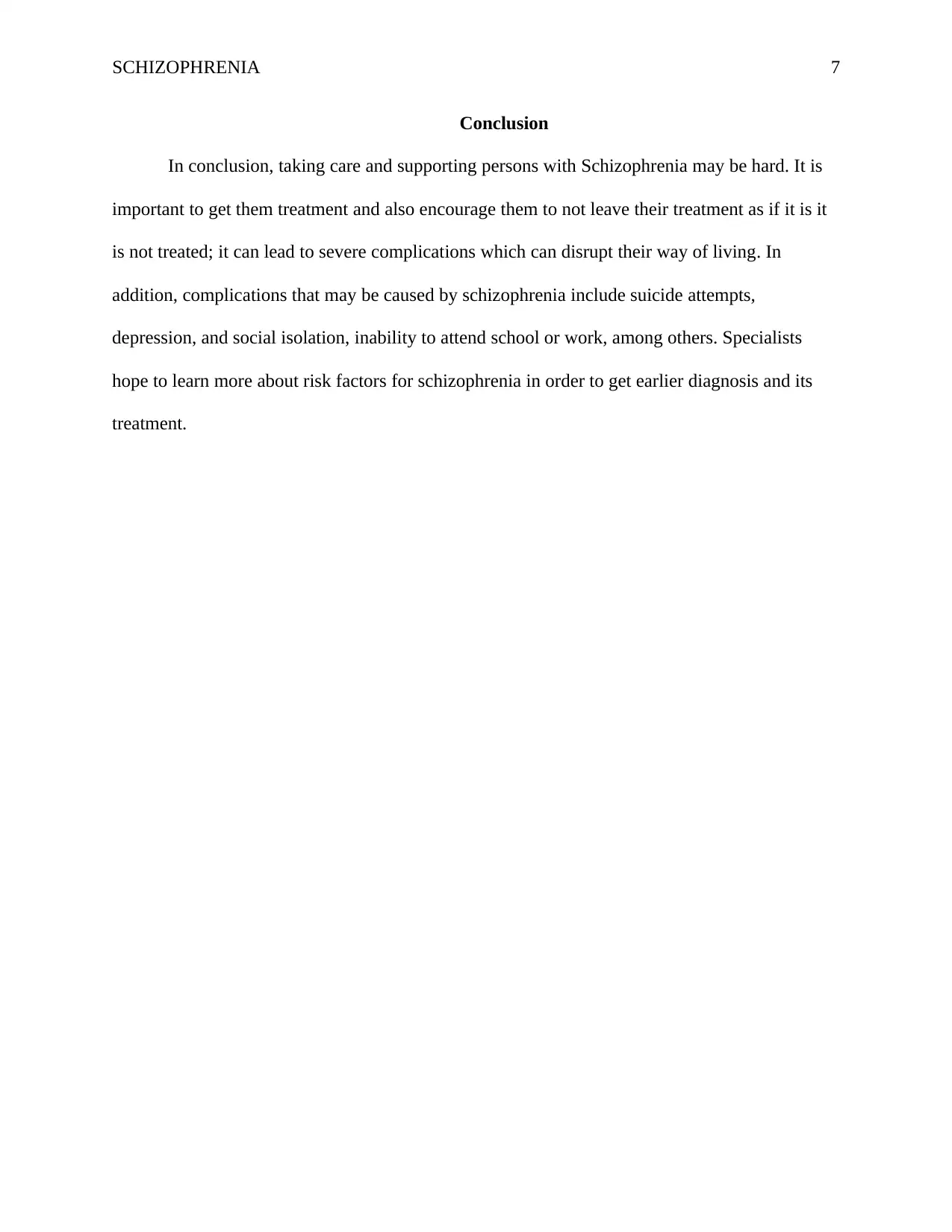
SCHIZOPHRENIA 7
Conclusion
In conclusion, taking care and supporting persons with Schizophrenia may be hard. It is
important to get them treatment and also encourage them to not leave their treatment as if it is it
is not treated; it can lead to severe complications which can disrupt their way of living. In
addition, complications that may be caused by schizophrenia include suicide attempts,
depression, and social isolation, inability to attend school or work, among others. Specialists
hope to learn more about risk factors for schizophrenia in order to get earlier diagnosis and its
treatment.
Conclusion
In conclusion, taking care and supporting persons with Schizophrenia may be hard. It is
important to get them treatment and also encourage them to not leave their treatment as if it is it
is not treated; it can lead to severe complications which can disrupt their way of living. In
addition, complications that may be caused by schizophrenia include suicide attempts,
depression, and social isolation, inability to attend school or work, among others. Specialists
hope to learn more about risk factors for schizophrenia in order to get earlier diagnosis and its
treatment.
Paraphrase This Document
Need a fresh take? Get an instant paraphrase of this document with our AI Paraphraser
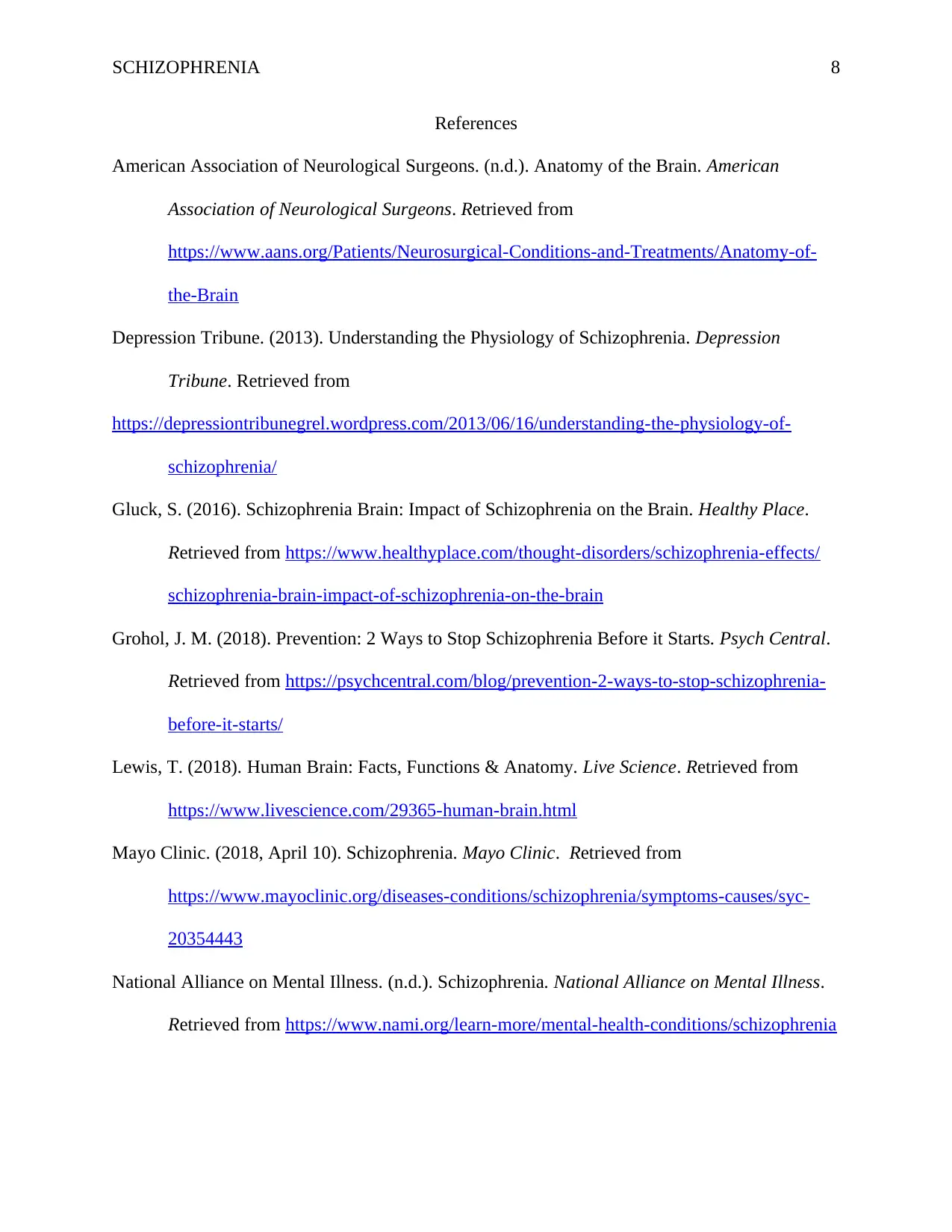
SCHIZOPHRENIA 8
References
American Association of Neurological Surgeons. (n.d.). Anatomy of the Brain. American
Association of Neurological Surgeons. Retrieved from
https://www.aans.org/Patients/Neurosurgical-Conditions-and-Treatments/Anatomy-of-
the-Brain
Depression Tribune. (2013). Understanding the Physiology of Schizophrenia. Depression
Tribune. Retrieved from
https://depressiontribunegrel.wordpress.com/2013/06/16/understanding-the-physiology-of-
schizophrenia/
Gluck, S. (2016). Schizophrenia Brain: Impact of Schizophrenia on the Brain. Healthy Place.
Retrieved from https://www.healthyplace.com/thought-disorders/schizophrenia-effects/
schizophrenia-brain-impact-of-schizophrenia-on-the-brain
Grohol, J. M. (2018). Prevention: 2 Ways to Stop Schizophrenia Before it Starts. Psych Central.
Retrieved from https://psychcentral.com/blog/prevention-2-ways-to-stop-schizophrenia-
before-it-starts/
Lewis, T. (2018). Human Brain: Facts, Functions & Anatomy. Live Science. Retrieved from
https://www.livescience.com/29365-human-brain.html
Mayo Clinic. (2018, April 10). Schizophrenia. Mayo Clinic. Retrieved from
https://www.mayoclinic.org/diseases-conditions/schizophrenia/symptoms-causes/syc-
20354443
National Alliance on Mental Illness. (n.d.). Schizophrenia. National Alliance on Mental Illness.
Retrieved from https://www.nami.org/learn-more/mental-health-conditions/schizophrenia
References
American Association of Neurological Surgeons. (n.d.). Anatomy of the Brain. American
Association of Neurological Surgeons. Retrieved from
https://www.aans.org/Patients/Neurosurgical-Conditions-and-Treatments/Anatomy-of-
the-Brain
Depression Tribune. (2013). Understanding the Physiology of Schizophrenia. Depression
Tribune. Retrieved from
https://depressiontribunegrel.wordpress.com/2013/06/16/understanding-the-physiology-of-
schizophrenia/
Gluck, S. (2016). Schizophrenia Brain: Impact of Schizophrenia on the Brain. Healthy Place.
Retrieved from https://www.healthyplace.com/thought-disorders/schizophrenia-effects/
schizophrenia-brain-impact-of-schizophrenia-on-the-brain
Grohol, J. M. (2018). Prevention: 2 Ways to Stop Schizophrenia Before it Starts. Psych Central.
Retrieved from https://psychcentral.com/blog/prevention-2-ways-to-stop-schizophrenia-
before-it-starts/
Lewis, T. (2018). Human Brain: Facts, Functions & Anatomy. Live Science. Retrieved from
https://www.livescience.com/29365-human-brain.html
Mayo Clinic. (2018, April 10). Schizophrenia. Mayo Clinic. Retrieved from
https://www.mayoclinic.org/diseases-conditions/schizophrenia/symptoms-causes/syc-
20354443
National Alliance on Mental Illness. (n.d.). Schizophrenia. National Alliance on Mental Illness.
Retrieved from https://www.nami.org/learn-more/mental-health-conditions/schizophrenia
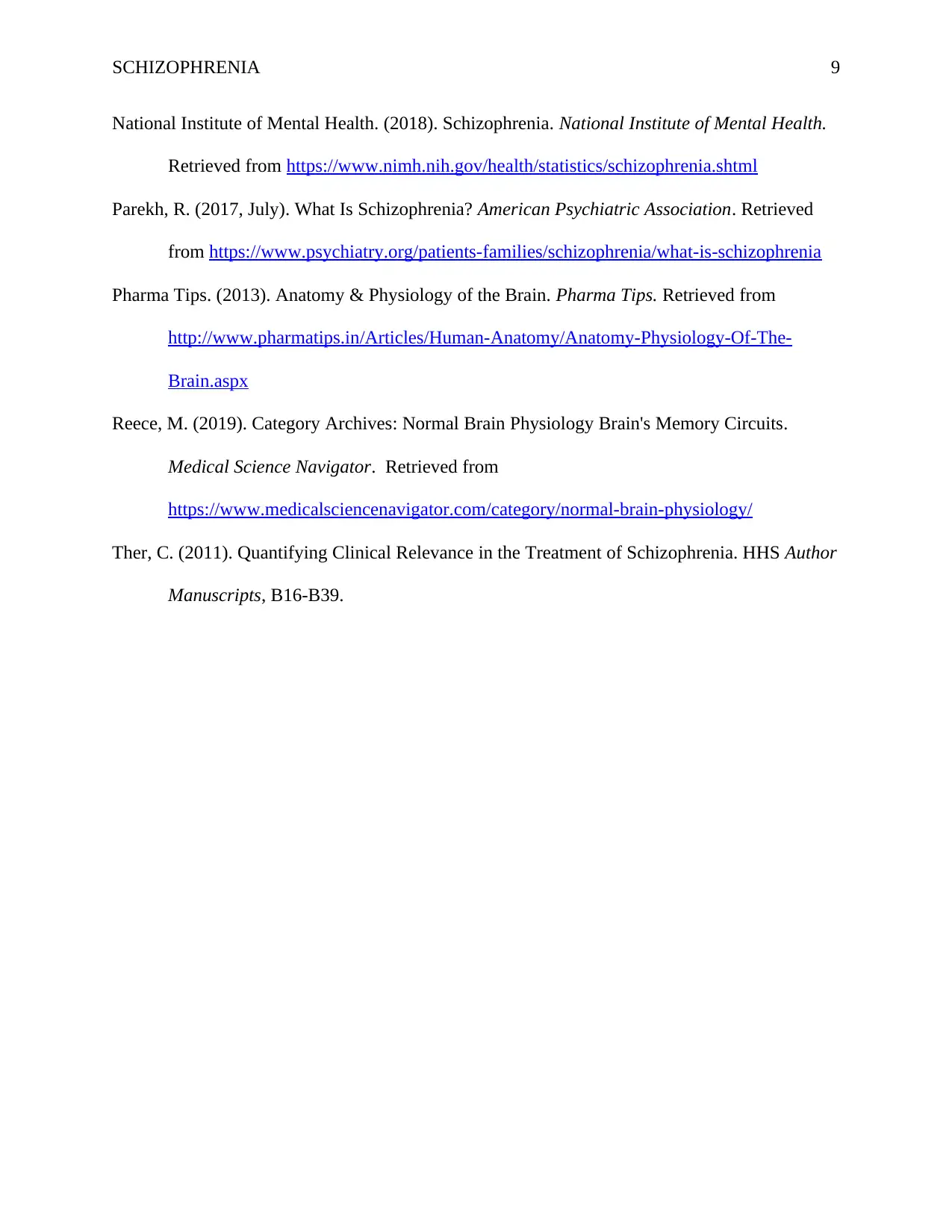
SCHIZOPHRENIA 9
National Institute of Mental Health. (2018). Schizophrenia. National Institute of Mental Health.
Retrieved from https://www.nimh.nih.gov/health/statistics/schizophrenia.shtml
Parekh, R. (2017, July). What Is Schizophrenia? American Psychiatric Association. Retrieved
from https://www.psychiatry.org/patients-families/schizophrenia/what-is-schizophrenia
Pharma Tips. (2013). Anatomy & Physiology of the Brain. Pharma Tips. Retrieved from
http://www.pharmatips.in/Articles/Human-Anatomy/Anatomy-Physiology-Of-The-
Brain.aspx
Reece, M. (2019). Category Archives: Normal Brain Physiology Brain's Memory Circuits.
Medical Science Navigator. Retrieved from
https://www.medicalsciencenavigator.com/category/normal-brain-physiology/
Ther, C. (2011). Quantifying Clinical Relevance in the Treatment of Schizophrenia. HHS Author
Manuscripts, B16-B39.
National Institute of Mental Health. (2018). Schizophrenia. National Institute of Mental Health.
Retrieved from https://www.nimh.nih.gov/health/statistics/schizophrenia.shtml
Parekh, R. (2017, July). What Is Schizophrenia? American Psychiatric Association. Retrieved
from https://www.psychiatry.org/patients-families/schizophrenia/what-is-schizophrenia
Pharma Tips. (2013). Anatomy & Physiology of the Brain. Pharma Tips. Retrieved from
http://www.pharmatips.in/Articles/Human-Anatomy/Anatomy-Physiology-Of-The-
Brain.aspx
Reece, M. (2019). Category Archives: Normal Brain Physiology Brain's Memory Circuits.
Medical Science Navigator. Retrieved from
https://www.medicalsciencenavigator.com/category/normal-brain-physiology/
Ther, C. (2011). Quantifying Clinical Relevance in the Treatment of Schizophrenia. HHS Author
Manuscripts, B16-B39.
1 out of 9
Related Documents
Your All-in-One AI-Powered Toolkit for Academic Success.
+13062052269
info@desklib.com
Available 24*7 on WhatsApp / Email
![[object Object]](/_next/static/media/star-bottom.7253800d.svg)
Unlock your academic potential
© 2024 | Zucol Services PVT LTD | All rights reserved.





